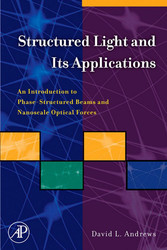Suchen und Finden
Mehr zum Inhalt

Structured Light and Its Applications - An Introduction to Phase-Structured Beams and Nanoscale Optical Forces
Front cover
1
Structured Light and Its Applications: An Introduction to Phase-Structured Beams and Nanoscale Optical Forces
4
Copyright page
5
Contents
6
Author Affiliations
12
Preface
14
Chapter 1. Introduction to Phase-Structured Electromagnetic Waves
16
1.1 Introduction
16
1.2 Laguerre-Gaussian Beams and Orbital Angular Momentum
17
1.3 Bessel and Mathieu Beams
22
1.4 General Solution of the Wave Equation
23
1.5 Classical or Quantum?
23
1.6 Creating Laguerre-Gaussian Beams with Lenses and Holograms
24
1.7 Coherence: Spatial and Temporal
26
1.8 Transformations Between Basis Sets
27
1.9 Conclusion
29
References
30
Chapter 2. Angular Momentum and Vortices in Optics
34
2.1 Introduction
34
2.2 Classical Angular Momentum of Fields and Particles
37
2.3 Separation of Radiative Angular Momentum in L and S
39
2.4 Multipole Fields and Their Vortex Structure
42
2.5 Angular Momentum of Monochromatic Paraxial Beams
48
2.6 Quantum Description of Paraxial Beams
55
2.7 Nonmonochromatic Paraxial Beam
57
2.8 Operator Description of Classical Paraxial Beams
63
2.9 Dynamics of Optical Vortices
70
2.10 Conclusion
74
References
75
Chapter 3. Singular Optics and Phase Properties
78
3.1 Fundamental Phase Singularities
79
3.2 Beams with Composite Vortices
84
3.3 Noninteger Vortex Beams
87
3.4 Propagation Dynamics
89
3.5 Conclusions
89
Acknowledgments
90
References
90
Chapter 4. Nanoscale Optics: Interparticle Forces
94
4.1 Introduction
94
4.2 QED Description of Optically Induced Pair Forces
97
4.3 Overview of Applications
113
4.4 Discussion
116
Acknowledgments
117
References
117
Chapter 5. Near-Field Optical Micromanipulation
122
5.1 Introduction
122
5.2 Theoretical Considerations for Near-Field Trapping
126
5.3 Experimental Guiding and Trapping of Particles in the Near Field
128
5.4 Emergent Themes in the Near Field
144
5.5 Conclusions
149
Acknowledgments
149
References
149
Chapter 6. Holographic Optical Tweezers
154
6.1 Background
154
6.2 Example Rationale for Constructing Extended Arrays of Traps
155
6.3 Experimental Details
157
6.4 Algorithms for Holographic Optical Traps
164
6.5 The Future of Holographic Optical Tweezers
177
Acknowledgments
177
References
177
Chapter 7. Atomic and Molecular Manipulation Using Structured Light
184
7.1 Introduction
184
7.2 A Brief Overview
185
7.3 Transfer of OAM to Atoms and Molecules
186
7.4 Doppler Forces and Torques
187
7.5 The Doppler Shift
195
7.6 Rotational Effects on Liquid Crystals
201
7.7 Comments and Conclusions
206
Acknowledgments
207
References
207
Chapter 8. Optical Vortex Trapping and the Dynamics of Particle Rotation
210
8.1 Introduction
210
8.2 Computational Electromagnetic Modeling of Optical Trapping
211
8.3 Electromagnetic Angular Momentum
214
8.4 Electromagnetic Angular Momentum of Paraxial and Nonparaxial Optical Vortices
217
8.5 Nonparaxial Optical Vortices
220
8.6 Trapping in Vortex Beams
226
8.7 Symmetry and Optical Torque
233
8.8 Zero Angular Momentum Optical Vortices
241
8.9 Gaussian ``Longitudinal'' Optical Vortex
243
8.10 Conclusion
246
References
246
Chapter 9. Rotation of Particles in Optical Tweezers
252
9.1 Introduction
252
9.2 Using Intensity Shaped Beams to Orient and Rotate Trapped Objects
253
9.3 Angular Momentum Transfer to Particles Held in Optical Tweezers
255
9.4 Out of Plane Rotation in Optical Tweezers
257
9.5 Rotation of Helically Shaped Particles in Optical Tweezers
258
9.6 Applications of Rotational Control in Optical Tweezers
259
References
262
Chapter 10. Rheological and Viscometric Methods
264
10.1 Introduction
264
10.2 Optical Torque Measurement
266
10.3 A Rotating Optical Tweezers-Based Microviscometer
269
10.4 Applications
279
Conclusion
283
References
283
Chapter 11. Orbital Angular Momentum in Quantum Communication and Information
286
11.1 Sending and Receiving Quantum Information
288
11.2 Exploring the OAM State Space
295
11.3 Quantum Protocols
301
11.4 Conclusions and Outlook
305
Acknowledgments
306
References
306
Chapter 12. Optical Manipulation of Ultracold Atoms
310
12.1 Background
310
12.2 Optical Forces and Atom Traps
311
12.3 The Quantum Gas: Bose-Einstein Condensates
314
12.4 Light-Induced Gauge Potentials for Cold Atoms
323
12.5 Light-Induced Gauge Potentials for the Lambda Scheme
326
12.6 Light-Induced Gauge Fields for a Tripod Scheme
335
12.7 Ultra-Relativistic Behavior of Cold Atoms in Light-Induced Gauge Potentials
338
12.8 Final Remarks
344
References
345
Index
350
Color Insert
358
Alle Preise verstehen sich inklusive der gesetzlichen MwSt.








